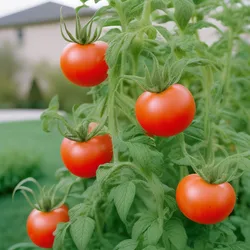
Simplified Story:
Growing juicy and flavorful tomatoes can be challenging, but with these ten tips, you can grow beautiful, healthy fruits. Choose the right variety that suits your climate and personal preference. Start with high-quality, disease-free seeds or seedlings, and prepare the soil by adding organic matter. Water your plants deeply and regularly, but avoid overwatering. Mulch your plants to retain soil moisture and regulate temperature. Fertilize regularly with a balanced or organic fertilizer, and prune your plants to improve air circulation. Support your plants with cages or stakes, and companion them with other plants to repel pests and improve soil health. Harvest your tomatoes at the right time by waiting until the fruits are fully ripe and brightly colored.
Full Story:
If you are a fan of juicy, fresh, and flavorful tomatoes, then you must be familiar with the frustration of growing a bumper crop of sickly and disappointing fruits. But worry not! With a little bit of planning, care, and some scientifically-proven tips, you can enjoy a bountiful harvest of beautiful, healthy, and juicy tomatoes. Here are the top 10 tips for growing tomatoes that will make your neighbors envious.
Choose the right variety: There are countless tomato varieties available in the market, each with its own unique flavor, texture, and growing conditions. Therefore, it is essential to choose the right variety that suits your climate, soil, and personal preference. For instance, if you live in a hot and humid region, you might want to go for heat-resistant and **disease-resistant** varieties, such as Roma or Celebrity.
Start with healthy seeds or seedlings: The quality of your tomato crop depends significantly on the quality of the seeds or seedlings you use. Therefore, always choose high-quality, disease-free, and **non-GMO** seeds or seedlings from a **reputable** source. You can also start your seeds indoors to give them a head start and better control over their growing conditions.
Prepare the soil properly: Tomatoes thrive in loose, well-draining, and nutrient-rich soil. Therefore, prepare your soil by adding organic matter, such as compost or aged manure, to improve its texture, **fertility**, and water retention capacity. Also, make sure the soil pH is between 6.0 and 7.0, as tomatoes prefer slightly acidic soil.
Water deeply and regularly: Tomatoes need consistent moisture to develop strong roots and juicy fruits. Therefore, water them deeply and regularly, especially during the hot and dry spells. However, avoid overwatering, as it can lead to root rot and other diseases.
**Mulch** your plants: Mulching is an effective way to retain soil moisture, suppress weeds, and regulate soil temperature. Therefore, add a layer of organic **mulch**, such as straw, leaves, or grass clippings, around your tomato plants, leaving some space around the stems to prevent fungal diseases.
Fertilize adequately: Tomatoes are heavy feeders and require regular **fertilization** to produce healthy and abundant fruits. Therefore, use a balanced fertilizer, such as 10-10-10, and apply it every 3-4 weeks during the growing season. You can also use organic fertilizers, such as fish emulsion or bone meal, for a more **sustainable** option.
Prune your plants: Pruning your tomato plants helps improve air circulation, reduce the risk of diseases, and direct more nutrients to the developing fruits. Therefore, remove the **suckers**, which are the small shoots that grow between the main stem and the branches, as they take away energy from the plant.
Support your plants: Tomatoes need support to grow upright and prevent their stems from breaking under the weight of the fruits. Therefore, use cages, stakes, or trellises to support your plants, and tie them gently with soft ties to avoid damaging the stems.
Companion your plants: Companion planting is a technique where you grow different plants together to benefit each other. Tomatoes have several companion plants, such as basil, marigold, and garlic, that can repel pests, attract pollinators, and improve soil health. Therefore, plant them together and enjoy the **synergistic** benefits.
Harvest at the right time: Harvesting your tomatoes at the right time ensures maximum flavor, juiciness, and nutrition. Therefore, wait until the fruits are fully ripe, firm, and brightly colored before harvesting them. You can also do a "wiggle test" to check if the fruitsQuestions:
What are some of the factors that affect the quality of tomato crops?
How can you choose the right tomato variety for your climate and personal preference?
In what ways can proper soil preparation improve the growth of tomato plants?
Do you agree that companion planting is an effective way to improve the health and productivity of tomato plants?
What are your personal tips for growing juicy and delicious tomatoes?
Fill In the Blanks:
Therefore, always choose high-quality, disease-free, and non-GMO seeds or seedlings from a ___ source.
Therefore, prepare your soil by adding organic matter, such as compost or aged manure, to improve its texture, ___, and water retention capacity.
___ your plants: Mulching is an effective way to retain soil moisture, suppress weeds, and regulate soil temperature.
Therefore, add a layer of organic ___, such as straw, leaves, or grass clippings, around your tomato plants, leaving some space around the stems to prevent fungal diseases.
Fertilize adequately: Tomatoes are heavy feeders and require regular ___ to produce healthy and abundant fruits.
You can also use organic fertilizers, such as fish emulsion or bone meal, for a more ___ option.
Therefore, remove the ___, which are the small shoots that grow between the main stem and the branches, as they take away energy from the plant.
Therefore, plant them together and enjoy the ___ benefits.
fertility, mulch, sustainable, reputable, synergistic, Mulch, fertilization, suckers
Vocabulary:
Bumper crop: a plentiful or abundant harvest
Disease-resistant: able to resist or tolerate diseases
Non-GMO: not genetically modified; free from genetic engineering
Reputable: having a good reputation; trustworthy
Fertility: the ability to produce offspring or fruit; the quality of being fertile
Mulch: a layer of organic material applied to the soil surface to improve soil fertility, water retention, and weed suppression
Fertilization: the process of adding fertilizers to the soil to enhance plant growth and productivity
Sustainable: able to be maintained at a certain level without depleting natural resources or causing harm to the environment
Suckers: small shoots that grow between the main stem and the branches of a plant
Synergistic: working together in a mutually beneficial way to produce a greater combined effect




